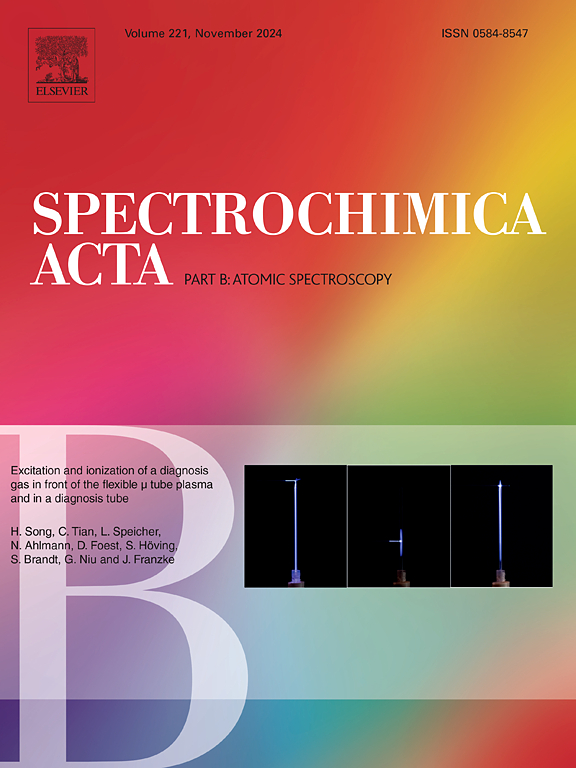Selective extraction and determination of trace metals by magnetic covalent organic frameworks with abundant thione and secondary amine groups coupled with ICP-MS
IF 3.2
2区 化学
Q1 SPECTROSCOPY
引用次数: 0
Abstract
A core-shell magnetic covalent organic frameworks (MCOF-SN) nanocomposite with high adsorption capacity was prepared by simply and directly coating covalent organic frameworks with abundant thione and secondary amine groups on the surface of magnetic nanoparticles, which were used to selectively extract copper (Cu2+), cadmium (Cd2+), lead (Pb2+), cobalt (Co2+) and nickel (Ni2+) ions prior to the detection by ICP-MS. The prepared magnetic covalent organic frameworks have high adsorption capacity of 52, 65, 162, 34 and 42 mg g−1 for Cu2+, Cd2+, Pb2+, Co2+ and Ni2+ ions, respectively. The analytical parameters affecting magnetic solid-phase extraction (MSPE) of metal ions were optimized. They were pH of sample, 4–5; eluent, 1 mL of 1 % (v/v) HNO3; amount of adsorbent, 15 mg; and sample volume, 200 mL. Under optimal experimental conditions, the limits of detection (LODs) of Cu2+, Cd2+, Pb2+, Co2+ and Ni2+ ions for water are 0.26, 0.16, 0.25, 0.08 and 0.17 ng L−1 with enrichment factors of 192, 191, 196, 188 and 190, and their relative standard deviations (RSD) were less than 5 % (20 ng L−1, n = 3), respectively. The LODs for Chinese herbal medicine samples were 0.52, 0.32, 0.50, 0.16 and 0.34 μg kg−1 based on 0.100 g sample, respectively. The proposed MSPE-inductively coupled plasma mass spectrometry (MSPE-ICP-MS) method with simple operation, high sensitivity and high anti-matrix interference ability has been successfully applied to the samples with complicated matrices, such as water and Chinese herbal medicine.

求助全文
约1分钟内获得全文
求助全文
来源期刊
CiteScore
6.10
自引率
12.10%
发文量
173
审稿时长
81 days
期刊介绍:
Spectrochimica Acta Part B: Atomic Spectroscopy, is intended for the rapid publication of both original work and reviews in the following fields:
Atomic Emission (AES), Atomic Absorption (AAS) and Atomic Fluorescence (AFS) spectroscopy;
Mass Spectrometry (MS) for inorganic analysis covering Spark Source (SS-MS), Inductively Coupled Plasma (ICP-MS), Glow Discharge (GD-MS), and Secondary Ion Mass Spectrometry (SIMS).
Laser induced atomic spectroscopy for inorganic analysis, including non-linear optical laser spectroscopy, covering Laser Enhanced Ionization (LEI), Laser Induced Fluorescence (LIF), Resonance Ionization Spectroscopy (RIS) and Resonance Ionization Mass Spectrometry (RIMS); Laser Induced Breakdown Spectroscopy (LIBS); Cavity Ringdown Spectroscopy (CRDS), Laser Ablation Inductively Coupled Plasma Atomic Emission Spectroscopy (LA-ICP-AES) and Laser Ablation Inductively Coupled Plasma Mass Spectrometry (LA-ICP-MS).
X-ray spectrometry, X-ray Optics and Microanalysis, including X-ray fluorescence spectrometry (XRF) and related techniques, in particular Total-reflection X-ray Fluorescence Spectrometry (TXRF), and Synchrotron Radiation-excited Total reflection XRF (SR-TXRF).
Manuscripts dealing with (i) fundamentals, (ii) methodology development, (iii)instrumentation, and (iv) applications, can be submitted for publication.

 求助内容:
求助内容: 应助结果提醒方式:
应助结果提醒方式:


